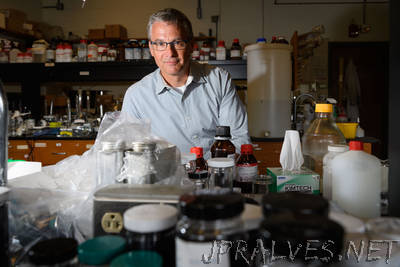
“Formed deep within the earth, stronger than steel, and thinner than a human hair. These comparisons aren’t describing a new super hero. They’re describing graphene, a substance that some experts have called “the most amazing and versatile” known to mankind.
UConn chemistry professor Doug Adamson, a member of the Polymer Program in UConn’s Institute of Materials Science, has patented a one-of-a-kind process for exfoliating this wonder material in its pure (unoxidized) form, as well as manufacturing innovative graphene nanocomposites that have potential uses in a variety of applications.
If you think of graphite like a deck of cards, each individual card would be a sheet of graphene. Comprised of a single layer of carbon atoms arranged in a hexagonal lattice, graphene is a two-dimensional crystal that is at least 100 times stronger than steel. Aerogels made from graphene are some of the lightest materials known to man, and the graphene sheets are one of the thinnest, at only one atom thick – that is approximately one million times thinner than a human hair. Graphene is also even more thermally and electrically conductive than copper, with minimal electrical charge.
Because of these unique qualities, graphene has been a hot topic for academic researchers and industry leaders since it was first isolated from graphite in 2004. Since then, more than 10,000 scholarly articles have been published about the material. But of these publications, only Adamson’s discusses a proprietary process for manufacturing graphene in its pristine form.
What others are calling “graphene” is often actually graphene oxide that has been chemically or thermally reduced. The oxygen in graphene oxide provides a sort of chemical handle that makes the graphene easier to work with, but adding it to pristine graphene reduces the material’s mechanical, thermal, and electrical properties in comparison to unmodified graphene like the kind Adamson produces.
It also significantly increases the cost to manufacture the material. Oxidizing graphite requires adding expensive hazardous chemicals, such as anhydrous sulfuric acid and potassium peroxide, followed by a lengthy series of manipulations to isolate and purify the products, known as a chemistry workup. Adamson’s process doesn’t require any additional steps or chemicals to produce graphene in its pristine form.”
